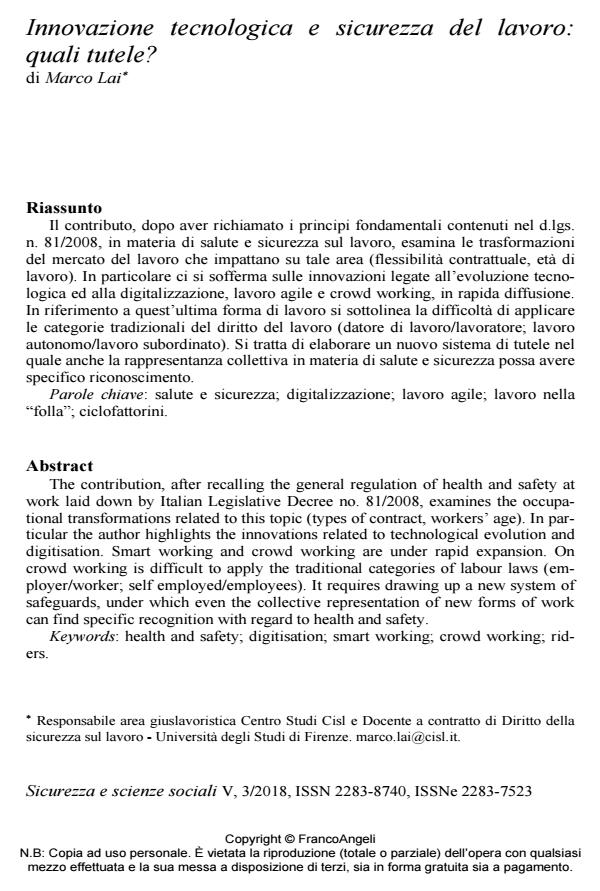Innovazione tecnologica e sicurezza del lavoro: quali tutele?
Journal title SICUREZZA E SCIENZE SOCIALI
Author/s Marco Lai
Publishing Year 2019 Issue 2018/3
Language Italian Pages 13 P. 83-95 File size 170 KB
DOI 10.3280/SISS2018-003006
DOI is like a bar code for intellectual property: to have more infomation
click here
Below, you can see the article first page
If you want to buy this article in PDF format, you can do it, following the instructions to buy download credits

FrancoAngeli is member of Publishers International Linking Association, Inc (PILA), a not-for-profit association which run the CrossRef service enabling links to and from online scholarly content.
The contribution, after recalling the general regulation of health and safety at work laid down by Italian Legislative Decree no. 81/2008, examines the occupa-tional transformations related to this topic (types of contract, workers’ age). In particular the author highlights the innovations related to technological evolution and digitisation. Smart working and crowd working are under rapid expansion. On crowd working is difficult to apply the traditional categories of labour laws (em-ployer/worker; self employed/employees). It requires drawing up a new system of safeguards, under which even the collective representation of new forms of work can find specific recognition with regard to health and safety.
Keywords: Health and safety; digitisation; smart working; crowd working; rid-ers.
- Dagnino E. (2016). Uber law: prospettive giuslavoristiche sulla sharing/on-demand economy. DRI, n. 1, 137 ss.
- Dagnino E. (2017). Una questione di fiducia: la reputazione ai tempi delle piattaforme online tra diritto alla privacy e prospettive di mercato. DRI, n. 1, 247 ss.
- Däubler W., Klebe T. (2016). Crowdwork: datore di lavoro in fuga? DRI, 2016, n. 151, 471 ss.
- De Stefano V. (2017). Lavoro «su piattaforma» e lavoro non standard in prospettiva nazionale e comparata. RGL, I, 255 ss.
- Donini A. (2016). Il lavoro su piattaforma digitale “prende forma” tra autonomia e subordinazione. Nuove regole per nuovi lavori? DRI, n. 1, 164 ss.
- Engblom S. (2017). Una prospettiva sindacale su digitalizzazione e Gig economy. RGL, I, 364 ss.
- Faioli M. (2017). Jobs «App», Gig-Economy e sindacato. RGL, I, 291 ss.
- Forlivesi M. (2016). La sfida della rappresentanza sindacale dei lavoratori 2.0. DRI, n. 3, 674 ss.
- Ichino P. (2017). Le conseguenze dell’innovazione tecnologica sul diritto del lavoro. RIDL, I, 525 ss.
- INAIL. (2017). Relazione Annuale 2017. Roma: 27 giugno 2018.
- Loy P. (2017). Il lavoro nella Gig economy nella prospettiva del rischio. RGL, I, 259 ss.
- Perulli A. (2015). Un Jobs Act per il lavoro autonomo: verso una nuova disciplina della dipendenza economica? Working Paper CSDLE “Massimo D’Antona” – IT, n. 235.
- Perulli A. (2017). Lavoro e tecnica al tempo di Uber. RGL, I, 195 ss.
- Prassl J., Risak M. (2017). Sottosopra e al rovescio: le piattaforme di lavoro on demand come datori di lavoro. RGL, I, 219 ss.
- Treu T. (2017). Rimedi e fattispecie a confronto con i lavori della Gig economy, WP CSDLE “Massimo D’Antona”. INT -136/2017.
- Tullini P. (2016). Digitalizzazione dell’economia e frammentazione dell’occupazione. Il lavoro instabile, discontinuo, informale: tendenze in atto e proposte d’intervento. RGL, n. 4, I, 748 ss.
- Voza R. (2017). Il lavoro e le piattaforme digitali: the same old story? WP CSDLE “Massimo D’Antona”, IT-336.
- Weiss M. (2016). Digitalizzazione: sfide e prospettive per il diritto del lavoro. DRI, n. 3, 652 ss.
Marco Lai, Innovazione tecnologica e sicurezza del lavoro: quali tutele? in "SICUREZZA E SCIENZE SOCIALI" 3/2018, pp 83-95, DOI: 10.3280/SISS2018-003006